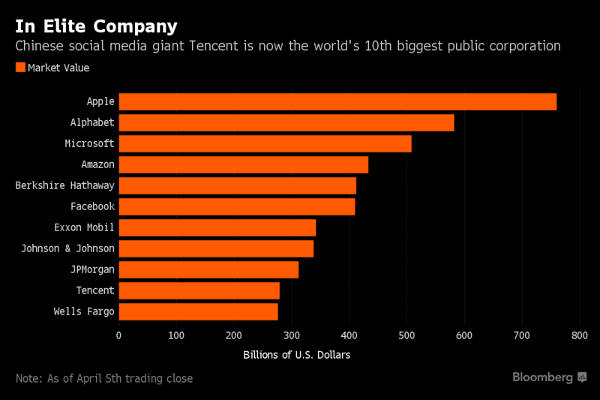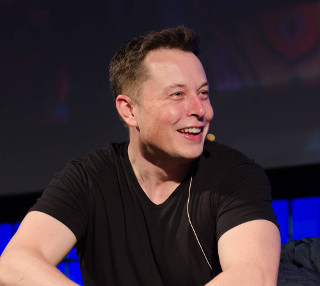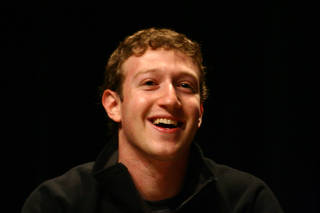[By steve under Creative Commons]
The future started yesterday, and we are already late
— John Legend
The year 2016 was, in a sense, an inevitable tipping point. It shone a harsh light on what every CEO knows and fears today. That if you are not a data-driven business, your firm’s journey to irrelevance has accelerated irretrievably.
The five tech firms—Apple, Google, Facebook, Amazon and Microsoft— catapulted ahead of the traditional giants in oil, banking and retail. Cumulatively they are now worth nearly $3 trillion. In China, the largest but most insulated internet market, the top tech companies command valuations in excess of $200 billion. Alibaba and Tencent (the owners of WeChat) nudge $300 billion and have little business outside China. In private markets too, a company in the throes of agony, Uber, was valued at $70 billion for what is essentially a taxi-on-tap service as it exists today.
A new billon-dollar company was born every third day in 2015. Several of these run by 25-year-old founders. It is estimated that over 500 unicorns (companies with valuations over $1 billion) were born over the last three years. Leaving out Microsoft and Apple, the old guards of tech companies, the new market favourites are fondly called FANG: Facebook, Amazon, Netflix and Google. They are the fastest growing and highest performing tech stocks.

The conglomerates, the oil companies, the big banks and manufacturers, are being relegated to dinosaur status. The media, which celebrated their dynastic stories of growth, now debates how long they will survive.
Will they adapt, is the question people ask. “Software is eating the world”, once the war-cry of Silicon Valley investors, is now passé. “Every company is a software company” is the new standard every CEO is measured by. The ones who cannot transform their own businesses will pay the price—rapid extinction. Corporates have recently become the biggest investors in startups. They are on a startup buying spree as a line of defence (and in some cases, as a peace offering to their public shareholders, while they tinker with their own lot).
Studying this technology tsunami is important for a couple of reasons. One, if you’re an incumbent, you need to be able to quickly pick up the right signals before it is too late, and fashion a strategic response. Or else, get steamrolled in their wake. Two, if you’re thinking of taking the plunge into tech entrepreneurship, you’ve got to grasp the new fundamentals of how new-age companies are likely to be built, and what it takes to create value.
The moat we own, in the moat we trust
BMW called 2016 its most successful year yet, selling nearly 2.4 million vehicles. Yet it was valued lower than Tesla, despite outselling the iconic firm that Elon Musk built nearly 25:1. Tesla sold just a little over 76,000 cars last year. BMW makes nearly as much profit every quarter as Tesla does revenues. Tesla currently loses money—$773 million in 2016; BMW made $7.7 billion. Yet the markets clearly love the software-at-heart company.

[Tesla co-founder Elon Musk. Photograph by Dan Taylor / Heisenberg Media under Creative Commons]
What gives? Very simply, investors are betting big to have a right on Tesla’s stream of profits in the future. If the entire automotive industry turns electric—which it might over the next decade—Tesla is likely to emerge as the reference brand. Or if Tesla’s battery pack or solar tile finds its way into every home. Elon Musk has suggested that Tesla could be worth $700 billion by 2025. You won’t find BMW making any such claims.
But how do you predict future profits and how do you value the stream of these profits? All valuation models aim at solving for the vagaries around these two questions. While calculating near-term profits of a firm is a science, valuing the defensibility and sustainability of the profits is what makes valuation an art.
Economic theory, and common sense, dictates that if a firm makes a lot of profit, it entices other firms to enter its segment, and the resultant competition cuts into its profits. That puts into question the sustainability (and predictability) of the profits and makes us examine the firm’s moat.
Moats can be of many kinds: the firm could have intellectual property (patents held by pharma/biotech/technology firms), or command a natural resource (oil and gas, diamonds), or be a licence holder in regulated markets (e.g. banks). At times, the sustainability of the moat is visualised in terms of the cost of replacing the production machinery of the firm (asset replacement—for example, a refinery or an older cement plant), or if the firm has built a strong legacy and brand which keeps consumers coming back for more (Coke, Pepsi, Apple). The firm may enjoy a defensible moat based on “how” it conducts business too, for example a unique distribution network (Amway), or an ability to spot and retain talent (McKinsey), or even the ability to lobby and contract with governments across the world (Defence and global mining giants). The job of a management team is to surround their firm with as many and as wide or deep a moat as possible.
Since the near-term profits of a firm are visible and predictable, the valuation is usually communicated in terms of its earnings multiple—how many times the current profit of the firm am I willing to pay for it today. The earnings multiple is a measure that tries to capture both the earnings potential of the firm and the quality of the earnings—i.e. their growth rate and their sustainability.
For instance, Netflix’ revenue in 2016 was $8.83 billion and it commands an earnings multiple of 202. Time Warner’s revenue in 2016 was $29.3 billion and its operating income $7.5 billion. But it trades at 18 times earnings. Both are roughly valued at $70 billion and analysts are gung-ho that Netflix will soon hit $100 billion in market cap. No one is making any such predictions for Time Warner. Airbnb is today valued more than Hilton or the Marriott. Just as Amazon has stolen a march over Walmart.
At a fundamental level, the issue is very simple. Traditional companies are valued with a mindset of “what can go wrong”—their moats are expected to always come under threat. Investors buying these companies try and calculate the sustainability of the moat and also how much of the current profits have to be sacrificed to continue sustaining that moat.
Technology firms have completely upended this model of valuation.
These firms are driven by a different set of fundamentals. Their factors of production are not just manufacturing, physical assets or distribution, but the embedded ability to get frictionless, low-cost access to customers over the internet.
They are able to instantly access markets and scale their offering. By virtue of their ability to reach millions of people in an instant, some are able to form a layer over traditional firms and aggregate supply and demand in ways never achieved before.
A variety of phenomenon have been studied on why these firms power themselves to scale so rapidly to gigantic proportions—which include network effects, ability to unbundle, ability to create new addressable markets, and exploit inefficiencies. Some simply grow on the back of content (and engagement) users create on their platforms. In this piece, I have referred largely to consumer internet businesses, but these principles apply to any firm that uses technology as a weapon for differentiation.
For instance, Netflix typified the bias for speed when it unveiled its service in 100 countries on the same day. Time Warner, by comparison, would have taken years.
The winners use data to keep iterating and focus on creating a bundle of offerings that are cheaper, easier to use and stickier as they are more personalised and customised, and they create network effects that become an entry barrier. In some cases, they are catapulted into virtuous cycles of network effects that make them so compelling to consumers and suppliers both, that their growth trajectory achieves a dimension of its own.
Hence, investors are not obsessed with the “sustainability” as much as they are funding them to create and expand their moats. They are usually betting on the stream of profit the firm does not have today, but could create in the future.
On razor’s edge
It took Uber five years to become the most valuable private company on earth. Its path to success was scripted by breaking the rules and crushing competition with capital. And it remains deeply unprofitable: net losses stood at $2.8 billion in 2016, and $708 million in the first three months of 2017. Last week, five of its key investors forced its high profile CEO Travis Kalanick to resign. Uber’s culture had been moulded around the leadership style. And Kalanick’s exit was preceded by a stream of exits from its leadership team, raising serious questions about its future.

[Uber co-founder Travis Kalanick. Photograph by Dan Taylor/Heisenberg Media under Creative Commons]
Does Uber’s monumental fall from grace mark the beginning of the end of the tech investing frenzy? Nothing could be further from the truth. At worst, it may create only a temporary pause.
The venture capital model driving this investing frenzy is typically a colossal bet on ideas and the founder. When investors see scalability and a disruptive business model, they are willing to pour in billions to discover the firm’s potential. As this amplifies, it creates a bubble. Every investor is actually trying to ride the wave of betting higher and higher on a firm in expectation that the next round investor will value it even more.
While nothing changes on the ground for a firm, its valuation skyrockets as investors play poker with each other on the firm’s “assumed" potential.
This constant drive to create, expand and deepen moats can become a heady game, for investors and founding teams alike. The spray-and-pray game is a birth child of the mobile boom in the last decade. And the bubbles arising from it aren't about to stop anytime soon. Largely because the smartphone is becoming a more versatile device with capability to process more, at higher speed, with more sensors and become the interface for other internet of things (IoT) devices that will surround us.
So in a sense the philosophy of the entire tech investing venture capital industry is the opposite of that of traditional growth capital: They don't ask “what can go wrong with the firm”, but “what can go right”. And that is also how mistakes tend to happen.
Uber’s heady run-up to the most valuable private company in the world is a result of this VC thinking. No one thought “what can go wrong”. And suddenly, things are such that there is no gravity holding Uber from flying apart.
The domino-like series of events that led to Uber’s descent is a bit like a moth attracted to the flame, unable to reverse course. Its story will inspire several case studies on what not to do, and bigger lessons to founders on how hubris can lead to ruination.
Uber may yet survive this challenge—it’s far too valuable in terms of customer stickiness and habit to just go under—but you’ll probably see a battered and bruised company.
Even in our own market, examples abound. Look around you and if you see a founder claiming world domination, you can probably spot the signs of a coming descent. The excesses of 2015/2016 have created a “post-founder” world—where we’ll see many more examples of investors taking charge of companies where founders went awry with their own sense of invincibility—an invincibility not born out of the strength of their business, but on moats made of just paper money.
And it is paradoxical: venture capitalists fund these companies precisely because they see the adrenalin-infused culture that gives these companies the ability to absorb and spend copious amounts of capital in the urge to dominate. But as we’ve seen time and again, when the combination of aggression and greed overtakes ethics and values, it creates a mutant, which then needs to be culled. Uber, Zenefits, Theranos are the so-called “mutant” outcomes of this frenzy.
Walking on thin ice
Imagine, you run a multibillion dollar business. One morning, after you announce estimate-beating earnings, your stock drops by 44% in a single session. It wipes out gains made over three years. That’s what happened to LinkedIn on February 4, 2016; $11 billion in shareholder wealth evaporated that morning. The company’s valuation slipped from $25 billion to $14 billion. Barely four months later, Microsoft acquired the firm for $26 billion.
Consider Twitter. A hot company which hit a peak valuation of $40 billion (it trades at about $13 billion now), it is now struggling to find a future (Google, Facebook, Salesforce could be potential buyers) after the market is replete with hot companies which suddenly nose-dived and have been struggling to prove their raison d’être. Snap is back to IPO value a few months after the most hyped IPO. Yahoo, Blackberry, Nokia, Myspace, AOL—the graveyard fills faster for the tech giant.

[Twitter co-founder and CEO Jack Dorsey. Photograph by JD Lasica.under Creative Commons]
You would think that high valuations and billions in the bank makes lives easy for these unicorns.
On the contrary, they are the most paranoid of businesses, whose future hangs by a thin thread. They know they have no assets to back them up. Most don’t actually make anything; they are just interfaces that help people reach out to things at the other end of a server. They have to prove their worth every single day.
The velocity of change is accelerating and even tech companies victims of it—the cycle of birth to death of a firm is growing shorter as they constantly lose relevance because the consumer is bombarded with new business models that are born in the age of connectedness and mobility. These new business models reset consumer expectations, and the switching costs are very low.
Now, here’s the key: some moats are large, but very shallow. Some are deep, but shrinking. The markets understand that. And gyrates accordingly.
Consider these statistics, and note the earnings multiples.
[Note: As of June 28, 2017. Source: Nasdaq. Hover the cursor over elements of the chart for more detail. While viewing on a smartphone, tap the elements.]
Spotify, Uber, Square, Snap, Pinterest—these are firms that make losses today but still command multibillion dollar price tags.
Why does Netflix enjoy a 202X earnings and Apple 17X? Apple technically has a bigger subscription base—over 600 million users (1.1 billion active devices) estimated for Apple and 100 million for Netflix—and has deeper access to its customers.
Now hypothetically, if Apple were to be valued like Amazon it would be worth $8 trillion. Both are mature companies, with deep stickiness. They’ve been listed for decades now and are studied intensely by the investing fraternity. What accounts for the vast difference in multiples? There is more to it than just the fact that Amazon is growing faster.
The hunt for optionality
In the summer of 2006, Yahoo decided to offer Facebook $1 billion. Facebook's investors and many of its executives wanted to sell. But Facebook was about to launch the News Feed, and if it went well, Mark Zuckerberg figured the company would be worth way more than a $1 billion. In any event, Yahoo lowered its offer to $850 million after announcing horrible Q2 earnings. According to an article on businessinsider.com, Facebook’s board took 10 minutes to reject the lowered offer.
Nearly ten years on, the very same Yahoo, which was once a $125 billion behemoth as big in its time as Facebook or Google are today, was finally sold to Verizon for comparative chump change: $5 billion.

[Facebook co-founder Mark Zuckerberg. Photograph by Jason McELweenie under Creative Commons]
What’s the mystery that drives these companies to stratospheric valuations and then sets them down so hard they can’t recover from the shock?
Here’s the upshot: It isn’t easy to model the growth of these tech companies. So what tools do investors use? After all, valuations aren’t driven by their current operations, but by their flexibility or adaptability and their ability to leverage their customer base. When you combine these two elements—how fast can this company adapt and how can it use its customer base—you get what investors look for in the business: “optionality”. In other words, their ability to enter and capture adjacencies.
Shareholders value them on not what’s obvious and predictable but what could be possible. And when that assessment disappoints, they crush the stocks. So it works both ways. LinkedIn collapses when investors sense that it cannot adapt and create optionality from its user base or that Snapchat (which recently went below its much hyped IPO price) will find it difficult to deliver a new trick.
Often investors aren’t able to see the optionality. But the founders do. The founders are visionary—they have a deeper understanding of what they are building, which is why you have these legendary stories. Founders can see what these firms can become. There are many examples of that. According to The Facebook Effect, as a startup, Facebook said no to as many as 11 offers—from the likes of Google, Viacom, News Corp, NBC, and of course, Yahoo. Clearly, Zuckerberg was confident not just about his ability to grow his user base (it has over 2 billion active users), but how to use his soaring valuation to invest in Facebook’s future. Facebook’s acquisition of WhatsApp, Instagram and Oculus Rift does just that.
Jeff Bezos decided never to turn a profit for over 20 years and then the day he turned in $41 million profit, the Amazon stock went into a frenzy and added $200 billion, taking it past Walmart. Snapchat refused to be bought out for $3 billion by Facebook and eventually listed at $20 billion.
Ditto for Uber. The ride share company’s $70 billion valuation does not rest on your taking a cab ride today, but on the possibility that Uber can be the winning platform in the self-driving race. That’s what investors were betting on. And that optionality is staggering, since it changes the cost structure of the personal and commercial transportation business. That optionality can be applied to the truck business. And Uber can partner every car company to put their cars directly on its platform.
However, if Uber slips in this self-driving race, it’ll destroy its optionality and revert to being valued as a utility which connects a cab to a customer, and optimises their experience like other data-driven marketplaces do.
Closer home, the valuation that investors place on Paytm, Flipkart or Zomato is based on the optionality these firms can create. The value is not in the current transactions they generate. The optionality resides in the habit they can create and whether the teams have the vision to expand into adjacencies. Flipkart will always be a valuable e-commerce player, but whether it becomes worth a $50 billion or not depends on how it can create new services and options for its customers and use their habit as a tool to create more value.
And these Indian internet giants have a once-in-a-lifetime opportunity to seize the biggest optionality for their tech business. After all, the entire nation is leapfrogging on the back of the public digital goods built on Aadhaar, e-KYC and other Aadhaar-related services. If you step back from the privacy and fundamental rights issues around Aadhaar, the fact that we can bring down transaction costs by creating a public trust and transaction layer is unparalleled in the world. This creates optionality for every internet entrepreneur and even the incumbents. The power of this platform is visible from the fact that we can walk into a mobile shop and walk out with an activated connection under a few minutes, or open a bank account in the blink of an eye. And one can clearly see the younger, newer banks and financial institutions latch on to it.
Read Part 2: There is a bigger battle brewing between the tech giants. And it is not about how they are deepening their moats, but how they are widening them. They are now playing into each others’ territory. That battle will be played out over the next few years, and all of us will be intimately involved in it—not just as observers but as participants.


